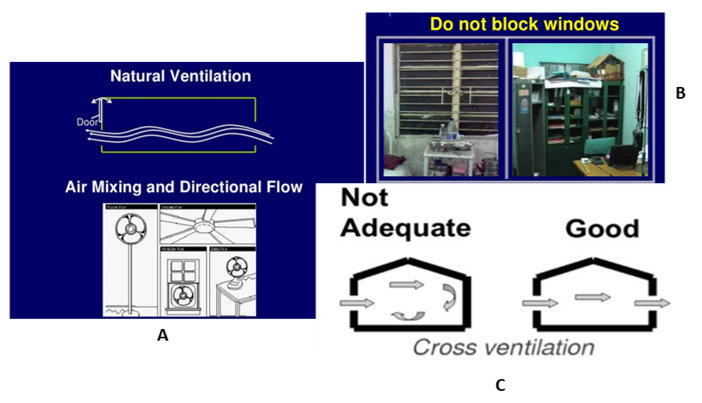Content Status
Type
Linked Node
Ventilation as an AIC Measure
Learning ObjectivesConcept of Air exchange, Types of ventilation-natural, mechanical and hybrid, special mention of exhausts for DMCs
Ventilation is defined as the supply/ distribution/ exchange or removal of air from spaces by mechanical or natural means.
Airflow is a natural process whenever there is change in temperature or pressure. Air keeps moving displacing the room air, and the time to replace the entire in-room air depends on the size of the room, the openings, and the presence of additional/mechanical force. This air-flow, also called ventilation, will allow the entry of outside air or clean recirculated air to remove extra heat, humidity and infectious aerosols from occupied spaces to meet health and comfort requirements.
When fresh air enters a room, it dilutes the concentration of particles in room air including aerosols responsible for the transmission of TB that can otherwise remain suspended in the air for significant periods of time.
Thus, ventilation is recognized as an important factor influencing the transmission of airborne diseases.
Types of Ventilation at TB Detection Centres
1. Natural Ventilation (Figure below)
- Natural ventilation is achieved by designing a laboratory layout that supports the unrestricted flow of natural air.
- Doors and windows should be kept open to bring in fresh air from outside.
- Opening windows and doors on opposite walls will also allow for cross ventilation.
- The placement of furniture, equipment, supplies etc. should not block or restrict the opening of doors and windows.

Figure: Natural ventilation achieved by opening doors and windows or using mechanical ventilation using fans and an exhaust fan for air mixing and directional flow (A); the flow of natural air should not be restricted by blocking doors and windows (B); Cross ventilation is not adequate if there is only one entry point for outside air (C); Source: Tuberculosis and HIV Co-Management and Tuberculosis And Airborne Infection Control.
2. Mechanical Ventilation: When the movement of air is driven by a mechanical device, it is called mechanical ventilation.
- TB diagnostic centres are equipped with fans and exhaust fans as the simplest means of mechanical ventilation for air circulation and directional flow of air. Exhaust fans fitted in windows/ ventilators exchange air from inside the laboratory to the outdoors.
- Ceiling fans/ tabletop fans/ pedestal fans have rotating blades to circulate air inside the room. Tabletop and pedestal fans can be positioned in the room to allow the directional flow of air.
- Tabletop and pedestal fans can be positioned in the room to allow the directional flow of air.
3. Hybrid/ Mixed-mode Ventilation
- In hybrid/ mixed-mode ventilation exhaust and/or fans are used in TB diagnostic centres in combination with natural ventilation to obtain adequate air dilution when sufficient airflow cannot be achieved by natural ventilation alone.
The table below compares the advantages and disadvantages of the different modes of ventilation.
Table: Summary of Advantages and Disadvantages of Different Types of Ventilation; Source: Guidelines on Airborne Infection Control in Healthcare and Other Settings.
| Mechanical Ventilation | Natural Ventilation | Hybrid (mixed-mode) Ventilation | |
| Advantages | Suitable for all climates and weather | Suitable for warm and temperate climates | Suitable for most climates and weather |
| More controlled and comfortable environment | Lower capital, operational, maintenance costs for simple implementations | Energy-saving relative to mechanical ventilation | |
| Occupants have limited control to affect ventilation | Capable of achieving very high ventilation rates | More flexible | |
| Disadvantages | Expensive to install and maintain | Easily affected by outdoor climate and occupants’ behaviour | May be more costly or difficult to design |
| Can fail to deliver required ventilation rates through faulty design, maintenance, or operation | May be difficult to plan, design, and predict performance | ||
| Noise from equipment | Reduced comfort level of occupants in extreme weather | ||
| Cannot achieve directional control of airflow, if required |
Resources
- Guidelines on Airborne Infection Control in Healthcare and Other Settings.
- Tuberculosis Infection Control, CDC.
- Tuberculosis and HIV Co-Management.
- Tuberculosis and Airborne Infection Control.
| Question | Answer 1 | Answer 2 | Answer 3 | All | Correct answer | Correct explanation | Page id | Part of Pre-test | Part of Post-test |
| In mixed-mode ventilation, exhaust and/or fans are used in combination with natural ventilation. | True | False | 1 | In mixed-mode ventilation, exhaust and/or fans are used in combination with natural ventilation. | Yes | Yes |
Page Tags
Content Creator
Reviewer
Target Audience
- Log in to post comments